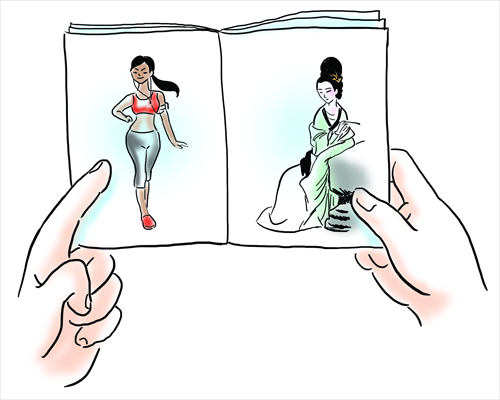Beauty comes in many varied forms

Illustration: Liu Rui/GT
The winner of the Miss Michigan beauty contest, the Beijing-born Chinese-American Arianna Quan, has faced a barrage of insults from Chinese netizens. "She is ugly and she can't represent us Chinese, let alone endorse the Chinese-style beauty," wrote one commentator. Others claimed she looked old, masculine, or otherwise "un-Chinese."
This isn't a phenomenon unique to Chinese-American women, naturally. Women's appearance faces a bevy of misogynist critics online. Even the most beautiful of actresses will have some ugly troll declaring her a "butterface," and unconventional looking women receive a volume of almost unimaginable abuse, as the cheerfully messy, older Oxford classicist Mary Beard did after presenting a BBC TV series. Of course, the idea of netizens - undoubtedly mostly male, and mostly young - judging anybody's looks is laughable. Most of the spotty, unwashed, pudgy denizens of the Internet aren't in a position to criticize others' appearance any more than they are their social graces or sporting ability.
But Chinese-American women in the public eye, particularly in professions associated with good looks, get a particular barracking from Chinese. I remember the passionate conviction of many of my friends that the eminently lovely Lucy Liu was "plain" or "ugly."
Part of this is simple, often unconscious, racism. Many of the women involved have a mixture of ancestry, usually European and Chinese, giving them a look mainlanders are unfamiliar with. Afro-Asian women come in for a particular bashing.
But part of it is also that they tend to be taller, stronger, and more active than the image of women that prevails on the mainland today. It also reflects the degree to which a single image of Chinese femininity has come to perversely dominate the national discourse. That image, of helpless, pale-skinned, slender, doe-eyed women, is an ungodly fusion from multiple sources, all of them with their own problems; Japanese animation, the modeling industry and traditional Chinese patriarchy. It's the same look we see created through plastic surgery trips to South Korea, or replicated on a million WeChat images; face poised at the camera, pointy-chinned and childish.
This is a shame; China is full of beautiful women - and handsome men. And it's full of variety: the tiny, elfish women of Yunnan, strong-faced and powerful Mongolians, broad-shouldered northern girls with the hearty good looks and ruddy skin of their peasant grandparents. The idea that a country of 1.3 billion people should be reduced to a single image of what women "should" look like is absurd.
If we're feeling historically inclined, we could trace this look all the way back to the Song Dynasty over 1,000 years ago, when the idea of helpless femininity began to dominate Chinese images of beauty. Tang Dynasty women, although portrayed as childish nymphs in many modern interpretations, were famously active. Even the most courtly beauties, like the famous Yang Guifei, the emperor's concubine, were Rubenesque lasses.
But it was at the same time in the Song - against the protests of social activists and reformers, even in long-ago Kaifeng and Hangzhou - that the sadistic process of foot-binding began to be introduced, reducing Chinese women to a mincing, painful walk in order to arouse men's perverted image of what femininity should be.
This image seemed to take particular hold in the Southern Song period, when the Song had been thoroughly beaten in war by the invading northern Jin armies. Perhaps it was the humiliated masculinity of Southern Song men that was forced to take refuge in an image of extreme femininity. The soft scholars of the later Song, given to fainting in moments of high emotion and having very deep thoughts about poetry, needed women who were even softer than them. That combined with a deep neo-Confucian sexism, a minority vision in the Song itself, but one that was given even greater weight by later scholars.
The Communist Party of China was once one of the most vigorous campaigners against this image of women reduced to nothing but ornament. Communist party posters, drawing on Soviet and wartime Western images of powerful, beautiful women, showed strong-armed women fighting, working, and holding their own. That's an image that Chinese could recapture today.
The author is an editor of the Global Times. jamespalmer@globaltimes.com.cn Follow us on Twitter @GTopinion